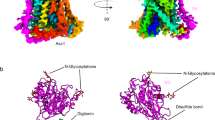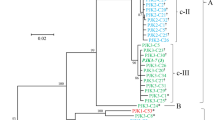Abstract
A cDNA encoding the mouse GABA transporter has been isolated and sequenced. The results show that the mouse GABA transporter cDNA differs from that of the rat by 60 base pairs at the open reading frame region but the deduced amino acid sequences of the two cDNAs are identical and both composed of 599 amino acids. However, the amino acid sequence is different from the sequence deduced from a recently published mouse GABA transporter cDNA.
Similar content being viewed by others
Introduction
The GABA transporter is a membraneous protein responsible for the cellular uptake or re-uptake of the neurotransmitter, γ-aminobutyric acid, from the synaptic cleft and hence for the termination of its synaptic activity1, 2. Complementary DNAs encoding the rat and human GABA transporters have been cloned and sequenced3, 4. The rat cDNA has been expressed in Xenopus oocytes which then exhibited GABA accumulating property5. From the sequencing data, it was deduced that the rat cDNA encoded a protein of 599 amino acids with probably 11 to 13 transmembrane regions. The human GABA transporter was also deduced to be made up of the same number of amino acids and the two amino acids sequences showed high degree of homology4. Independently, we also obtained a cDNA fragment encoding the human GABA transporter from a human brain substantia nigra cDNA library by polymerase chain reaction(PCR) technique3. With this cDNA fragment as probe, a cDNA clone encoding the mouse GABA transporter was isolated from a mouse brain stem cDNA library and the cDNA was sequenced. While this work was in progress, the sequence of a mouse GABA transporter cDNA and the exon-intron structure of the mouse GABA gene were published by Liu et al.4 A comparison of the published sequence and our sequencing data showed a considerable degree of discrepancy despite that both we and the other group used similar techniques and materials in obtaining our respective cDNAs. We report here the isolation and sequencing of our mouse GABA transporter cDNA. A comparsion of this sequence with that of the rat cDNA and the published mouse cDNA is made and the significance discussed.
Materials and Methods
An oligo dT primed mouse brain cDNA library in Lambda Uni-ZapTMXR obtained from Stratagene was used in this study. The library contained approxiamtely 2.0 ×106 primary plaques with an average insert size of 1.5 Kb. A cDNA fragment of approxiamately 1.8 Kb in length encoding the human GABA transporter cloned by Lam et al.3 was 32P-labled by nick translation and used as probe to screen the library by the Stratagene protocol. After screening and plaque purification, pBluescript plasmids with positive inserts were excised from the selected Lambda vectors and transformed into E.coli strain BB4. Plasmids purified from the transformants were cut by EcoR I and Xho I to release the inserts. Two oligonucleotides, primer I and primer II, which corresponded respectively to the 5′ and 3′ ends of the reading frame of the human GABA transporter cDNA and were originally designed by Lam et al.3 for PCR experiments, were used to identify inserts with complete reading frame by Southern hybridization. The selected cDNA clone was then mapped by restriction enzymes. Overlapping restriction fragments obtained were cloned into plasmid pTZ18U and pTZ19U for dideoxy sequencing (Pharmacia T7 Sequencing Kit and Gene-ATAQ Sequencing Kit). Inserts too long to be completely sequenced once were shortened by Nuclease Ba131 before subcloning and sequencing. Sequencing data were analyzed using PC / Gene software on an IBM compatible personal computer
Result and Discussion
After screening 7.5×106 recombinant plaques plated out from the mouse brain cDNA library, five recombinants that gave comparatively stronger hybridization signals were selected out of some thirty positive plaques. Following phagemid excision and reinfection, the pBluescript derivatives were purified and the inserts excised. All inserts hybridized with primer II but only one hybridized with primer I, indicating that this was the only inserts wiht a complete reading frame of the GABA transporter. This insert, designated as MGAT, was the longest among the five and was about 4.2 Kb in length. It must be added here that the ease of obtaining the target cDNA indicates that the mouse brain is rich in GABA transporter mRNA.
Ten restriction enzymes were used to map MGAT. The result is shown in Fig 1. This map is very much different from that of the rat GABA transporter cDNA (data not shown). Sequencing results shows that the cDNA consists of a long 3′ noncoding region of 2.3 Kb and a complete open reading frame of 1797 bp. The sequence of the 5′ region including the open reading frame was compared with the sequences of the rat i.e. composed of 599 amino acids. The reading frames of the two cDNAs differs from each other by 60bp. However, with the exception of one bp, all of the differences occur at the third position of a codon and result in no variation in the two amino acid sequences. The difference at nucleotide 1308 (G versus C) which is at the first position of a codon for leucine also results in no amino acid divergence. On the other hand, the mouse GABA transporter amino acid sequence as deduced form the published cDNA sequence of Liu et al.4 is amino acid shorter i.e. Pro 213 is missing. In addition, it differs from the other two GABA transporters1, 3, 5 by 7 amino acids, despite that there is only a 14 bp difference between the open reading frames of the two mouse cDNA sequences.
The human GABA transporter differs from the rat GABA transporter by 17 amino acids, but all except one of those residues are located at the N- and C- terminal regions of the proteins5. In a region starting from Asp 40 to Phe 512 (473 A.A. in length), the two amino acids sequences are almost identical with only leu 179 in rat replaced by a methionine in human. The conservation of the GABA transporter in rat and human indicated that the conformation of the protein is important to its functioning. Therefore it is within our expectation to found that the mouse GABA transporter (MGAT) amino acid sequence is identical to that of the rat. We are suprised to learn that the mouse GABA transpoter amino acid sequence as published by Liu et al.4 differs from that of the rat by such extend and that all discrepencies occur at the central conserved region of the peptides. A proline residue, which is present at position 213 of the GABA transporter sequence of rat but not at that of the publisehed mouse sequence, is known to be rigid and when occurs on a polypeptide is likely to create a rigid bend. Two bulky tryptophan residues in rat are replaced by two comparatively smaller residues in mouse (Cys 212 and Ile 285) and leu 118 in rat is replaced by a tryptophan residue in mouse. All these would result in conformational differences between the two transporters.
As we worked on our sequencing of MGAT, we encountered problems due to band compressions and occurrence of secondary structure in the templates. These problems were subsequently solved by various means8. We are sure that the discrepencies in the sequencing results as reported by us and by Liu et al.4 were not due to our misreadings of the sequence. As the presence of a variety of GABA transporter subtypes has been suggested7, we do not rule out that we and the other group were dealing with different subtypes of the GABA transporter in mouse. We have now isolated a fragment and are in the process of sequencing both the exons and introns regions. By comparing the exon-intron structure of our genomic fragment with that as reported by Liu et al. 4, we will be able to tell whether there exit two GABA transporters genes in mouse.
Nucleotide and deduced amino acid sequences of the mouse GABA transporter cDNA, MGAT. Aligned with the MGAT sequence is the rat GABA transporter cDNA sequence as reported by Guastella et. al. and the mouse GABA transporter cDNA sequence as reported by Liu et al. Dashes in the sequences represent nucleotides identical to that of MGAT. The first nucleotide at the start site is designated as position one. Below is the amino acid sequence deduced from MGAT and aligned with it is the mouse GABA transporter amino acids sequence as reported by Liu et al. Dashes in the last sequence represent amino acid residues identical to that deduced from MGAT.
References
Guastella J, Nelson N, Nelson H, et al. Cloning and expression of a rat brain GABA transporter. Science 1990; 249:1303–6.
Kanner BI, Schuldiner S . Mechanism of transport and storage of neurotransmitters. CRC Crit. Rev. Biochem. 1987; 22:1–38.
Lam DMK, Fei J, Zhang XY, et al. Molecular cloning and structure of the human (GABATHG) GABA transporter gene. Molecular Brain Research 1993; 19:227–32.
Liu QR, Mandiyan S, Nelson H, Nelson N . A family of genes encoding neurotransmitter transporters. PNAS 1992; 89:6639–43.
Nelson H, Mandiyan S, Nelson N . Cloning of the human GABA transporter. FEBS Letter 1990; 269:181–4.
Radian R, Bendahan A, Kanner BI . Purification and identification of the functional sodium-and chloride-coupled-aminobutyric acid transport glycoprotein from rat brain. J Biol Chem. 1986; 261:15437–41.
Wood JD, Sidhu HS . A comparative study and partial characterization of multi-uptake systens for -aminobutyric acid. J Neurochem. 1987;49:1202–8.
The T7 SequencingTM Kit from Pharmacia was used for routine sequencing. The band compressions problems were solved either by substituting 7-deaza dGTP and 7-deaza DAPT for dGTP and dATP in the sequencing mixes (supplied as Deaza G?A T7 SequencingTM Mixes by Pharmacia) or by sequencing the templates from both ends. The problems due to secondary structures were solved by using the Gene-ATAQTM Sequencing Kit from Pharmacia which employs high temperature and Taq DNA polymerase in the sequencing reactions.
Author information
Authors and Affiliations
Rights and permissions
About this article
Cite this article
Tam, A., Guo, L. & Kit Lam, D. Cloning and sequencing of mouse GABA transporter complementary DNA. Cell Res 4, 109–116 (1994). https://doi.org/10.1038/cr.1994.11
Received:
Revised:
Accepted:
Issue Date:
DOI: https://doi.org/10.1038/cr.1994.11
Keywords
This article is cited by
-
γ-Aminobutyric acid transporter (GAT1) overexpression in mouse affects the testicular morphology
Cell Research (2000)
-
Inhibition of uptake, steady-state currents, and transient charge movements generated by the neuronal GABA transporter by various anticonvulsant drugs
British Journal of Pharmacology (1999)
-
Characterization of 5′-proximal sequence of mouse GABA transporter gene (GAT-1)
Cell Research (1997)





